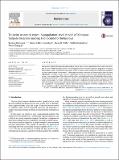To swim or not to swim : a population-level model of Xenopus tadpole decision making and locomotor behaviour
Abstract
We present a detailed computational model of interacting neuronal populations that mimic the hatchling Xenopus tadpole nervous system. The model includes four sensory pathways, integrators of sensory information, and a central pattern generator (CPG) network. Sensory pathways of different modalities receive inputs from an “environment”; these inputs are then processed and integrated to select the most appropriate locomotor action. The CPG populations execute the selected action, generating output in motor neuron populations. Thus, the model describes a detailed and biologically plausible chain of information processing from external signals to sensors, sensory pathways, integration and decision-making, action selection and execution and finally, generation of appropriate motor activity and behaviour. We show how the model produces appropriate behaviours in response to a selected scenario, which consists of a sequence of “environmental” signals. These behaviours might be relatively complex due to noisy sensory pathways and the possibility of spontaneous actions.
Citation
Borisyuk , R , Merrison-Hort , R , Soffe , S R , Koutsikou , S & Li , W-C 2017 , ' To swim or not to swim : a population-level model of Xenopus tadpole decision making and locomotor behaviour ' , BioSystems , vol. 161 , pp. 3-14 . https://doi.org/10.1016/j.biosystems.2017.07.004
Publication
BioSystems
Status
Peer reviewed
ISSN
0303-2647Type
Journal article
Description
Authors thank the Biotechnology and Biological Sciences Research Council (BB/L002353/1; BB/L000814/1; BB/L00111X/1) for support.Collections
Items in the St Andrews Research Repository are protected by copyright, with all rights reserved, unless otherwise indicated.

